A Composite Membrane with High Stability and Low Cost Specifically for Iron–Chromium Flow Battery
Abstract
:1. Introduction
2. Experimental Section
2.1. Materials
2.2. Membrane Preparation
2.3. Chemical Structure
2.4. Membrane Morphology
2.5. Water Uptake
2.6. Contact Angle
2.7. Iron Ion Permeability
2.8. Area Resistance
2.9. Battery Performance
2.10. Stability Test
3. Results
3.1. The Fabrication of the Composite Membranes
3.2. The Characterizations of the Composite Membranes
3.3. The Optimization of Nafion Resin Amount
3.4. ICFB Battery Performance
3.5. The Stability of the Composite Membranes
3.6. Cost Calculation
4. Conclusions
Supplementary Materials
Author Contributions
Funding
Institutional Review Board Statement
Informed Consent Statement
Data Availability Statement
Acknowledgments
Conflicts of Interest
References
- Chu, S.; Cui, Y.; Liu, N. The path towards sustainable energy. Nat. Mater. 2017, 16, 16–22. [Google Scholar] [CrossRef] [PubMed]
- Yang, Z.; Zhang, J.; Kintner-Meyer, M.C.; Lu, X.; Choi, D.; Lemmon, J.P.; Liu, J. Electrochemical energy storage for green grid. Chem. Rev. 2011, 111, 3577–3613. [Google Scholar] [CrossRef] [PubMed]
- Dunn, B.; Kamath, H.; Tarascon, J.-M. Electrical energy storage for the grid: A battery of choices. Science 2011, 334, 928–935. [Google Scholar] [CrossRef] [Green Version]
- Soloveichik, G.L. Flow batteries: Current status and trends. Chem. Rev. 2015, 115, 11533–11558. [Google Scholar] [CrossRef]
- Ding, Y.; Zhang, C.; Zhang, L.; Zhou, Y.; Yu, G. Pathways to widespread applications: Development of redox flow batteries based on new chemistries. Chem 2019, 5, 1964–1987. [Google Scholar] [CrossRef]
- Winsberg, J.; Hagemann, T.; Janoschka, T.; Hager, M.D.; Schubert, U.S. Redox-flow batteries: From metals to organic redox-active materials. Angew. Chem. Int. Ed. 2017, 56, 686–711. [Google Scholar] [CrossRef]
- Noack, J.; Roznyatovskaya, N.; Herr, T.; Fischer, P. The chemistry of redox-flow batteries. Angew. Chem. Int. Ed. 2015, 54, 9776–9809. [Google Scholar] [CrossRef]
- Park, M.; Ryu, J.; Wang, W.; Cho, J. Material design and engineering of next-generation flow-battery technologies. Nat. Rev. Mater. 2017, 2, 16080. [Google Scholar] [CrossRef]
- Ahn, Y.; Moon, J.; Park, S.E.; Shin, J.; Choi, J.W.; Kim, K.J. High-performance bifunctional electrocatalyst for iron-chromium redox flow batteries. Chem. Eng. J. 2021, 421, 127855. [Google Scholar] [CrossRef]
- Wang, S.; Xu, Z.; Wu, X.; Zhao, H.; Zhao, J.; Liu, J.; Yan, C.; Fan, X. Excellent stability and electrochemical performance of the electrolyte with indium ion for iron–chromium flow battery. Electrochim. Acta 2021, 368, 137524. [Google Scholar] [CrossRef]
- Wang, S.; Xu, Z.; Wu, X.; Zhao, H.; Zhao, J.; Liu, J.; Yan, C.; Fan, X. Analyses and optimization of electrolyte concentration on the electrochemical performance of iron-chromium flow battery. Appl. Energy 2020, 271, 115252. [Google Scholar] [CrossRef]
- Thaller, L.H. Electrically rechargeable redox flow cells. In Proceedings of the 9th Intersociety Energy Conversion Engineering Conference, San Francisco, CA, USA, 26–30 August 1974; pp. 924–928. [Google Scholar]
- Lin, Y.; Han, W.; Xiaomeng, L.; Zhao, Z.; Yuanjie, Z.; Yujia, L.; Yun, L. Introduction and engineering case analysis of 250 kW/1.5 MW h iron-chromium redox flow batteries energy storage demonstrationpower station. Energy Storage Sci. Technol. 2020, 9, 751. [Google Scholar] [CrossRef]
- Gahn, R.F.; Hagedorn, N.H.; Ling, J.S. Single-Cell-Performance Studies on the Fe/Cr Redox Energy-Storage System Using Mixed-Reactant Solutions at Elevated Temperature; National Aeronautics and Space Administration, Lewis Research Center: Cleveland, OH, USA, 1983. [Google Scholar]
- Zeng, Y.; Zhao, T.; Zhou, X.; Zeng, L.; Wei, L. The effects of design parameters on the charge-discharge performance of iron-chromium redox flow batteries. Appl. Energy 2016, 182, 204–209. [Google Scholar] [CrossRef]
- Arora, P.; Zhang, Z. Battery separators. Chem. Rev. 2004, 104, 4419–4462. [Google Scholar] [CrossRef] [PubMed]
- Zeng, S.; Zeng, L.; Wang, R.; Guo, W.; Tang, H. Effect of elevated temperature annealing on Nafion/SiO2 composite membranes for the All-Vanadium redox flow battery. Polymers 2018, 10, 473. [Google Scholar] [CrossRef] [Green Version]
- Chen, Q.; Ding, L.; Wang, L.; Yang, H.; Yu, X. High proton selectivity sulfonated polyimides ion exchange membranes for vanadium flow batteries. Polymers 2018, 10, 1315. [Google Scholar] [CrossRef] [PubMed] [Green Version]
- Cui, Y.; Chen, X.; Wang, Y.; Peng, J.; Zhao, L.; Du, J.; Zhai, M. Amphoteric ion exchange membranes prepared by preirradiation-induced emulsion graft copolymerization for vanadium redox flow battery. Polymers 2019, 11, 1482. [Google Scholar] [CrossRef] [Green Version]
- Chen, D.; Li, D.; Li, X. Hierarchical porous poly (ether sulfone) membranes with excellent capacity retention for vanadium flow battery application. J. Power Sources 2017, 353, 11–18. [Google Scholar] [CrossRef]
- Zhao, Y.; Yuan, Z.; Lu, W.; Li, X.; Zhang, H. The porous membrane with tunable performance for vanadium flow battery: The effect of charge. J. Power Sources 2017, 342, 327–334. [Google Scholar] [CrossRef]
- Oldenburg, F.J.; Schmidt, T.J.; Gubler, L. Tackling capacity fading in vanadium flow batteries with amphoteric membranes. J. Power Sources 2017, 368, 68–72. [Google Scholar] [CrossRef]
- Qin, X.-H.; Du, Y.-H.; Zhang, P.-C.; Wang, X.-Y.; Lu, Q.-Q.; Yang, A.-K.; Sun, J.-C. Layered barium vanadate nanobelts for high-performance aqueous zinc-ion batteries. Int. J. Min. Met. Mater. 2021, 28, 1684–1692. [Google Scholar] [CrossRef]
- Du, Y.-H.; Liu, X.-Y.; Wang, X.-Y.; Sun, J.-C.; Lu, Q.-Q.; Wang, J.-Z.; Omar, A.; Mikhailova, D. Freestanding strontium vanadate/carbon nanotube films for long-life aqueous zinc-ion batteries. Rare Met. 2022, 41, 415–424. [Google Scholar] [CrossRef]
- Sun, C.Y.; Zhang, H. Investigation of Nafion series membranes on the performance of iron-chromium redox flow battery. Int. J. Energy Res. 2019, 43, 8739–8752. [Google Scholar] [CrossRef]
- Sun, C.-Y.; Zhang, H.; Luo, X.-D.; Chen, N. A comparative study of Nafion and sulfonated poly (ether ether ketone) membrane performance for iron-chromium redox flow battery. Ionics 2019, 25, 4219–4229. [Google Scholar] [CrossRef]
- Qiao, L.; Zhang, H.; Lu, W.; Xiao, C.; Fu, Q.; Li, X.; Vankelecom, I.F. Advanced porous membranes with slit-like selective layer for flow battery. Nano Energy 2018, 54, 73–81. [Google Scholar] [CrossRef]
- Charles, M. Hansen Hansen Solubility Parameters: A User’s Handbook; CRC Press: New York, NY, USA, 1998. [Google Scholar]
- Snavely, D.; Dubsky, J. Near-IR spectra of polyethylene, polyethylene glycol, and polyvinylethyl ether. J. Polym. Sci. Part A Polym. Chem. 1996, 34, 2575–2579. [Google Scholar] [CrossRef]
- Zhang, H.; Zhang, H.; Li, X.; Mai, Z.; Wei, W. Silica modified nanofiltration membranes with improved selectivity for redox flow battery application. Energy Environ. Sci. 2012, 5, 6299–6303. [Google Scholar] [CrossRef]
- Liang, Z.; Chen, W.; Liu, J.; Wang, S.; Zhou, Z.; Li, W.; Sun, G.; Xin, Q. FT-IR study of the microstructure of Nafion® membrane. J. Membr. Sci. 2004, 233, 39–44. [Google Scholar] [CrossRef]
- Zeng, Y.; Zhao, T.; An, L.; Zhou, X.; Wei, L. A comparative study of all-vanadium and iron-chromium redox flow batteries for large-scale energy storage. J. Power Sources 2015, 300, 438–443. [Google Scholar] [CrossRef]
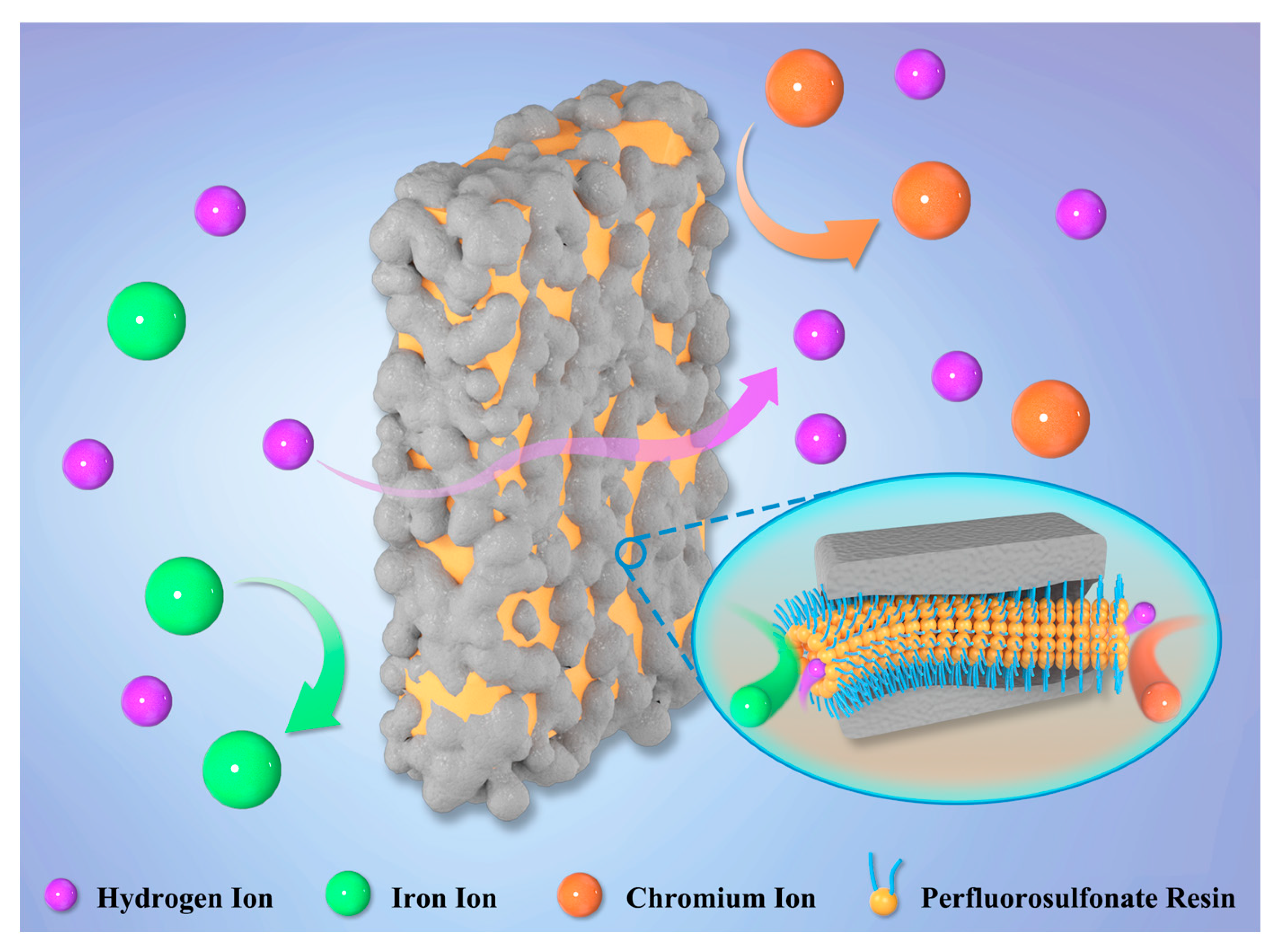


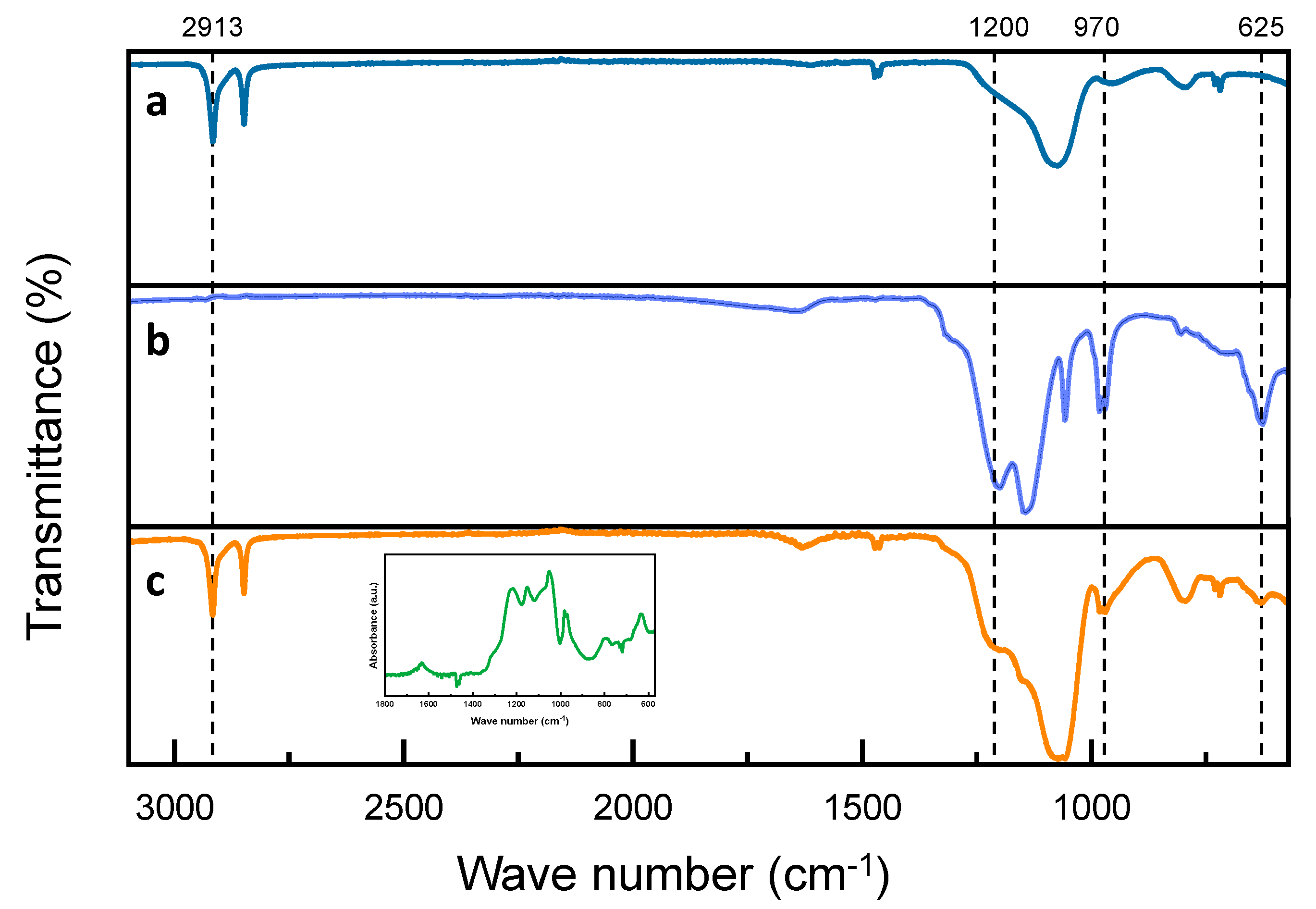
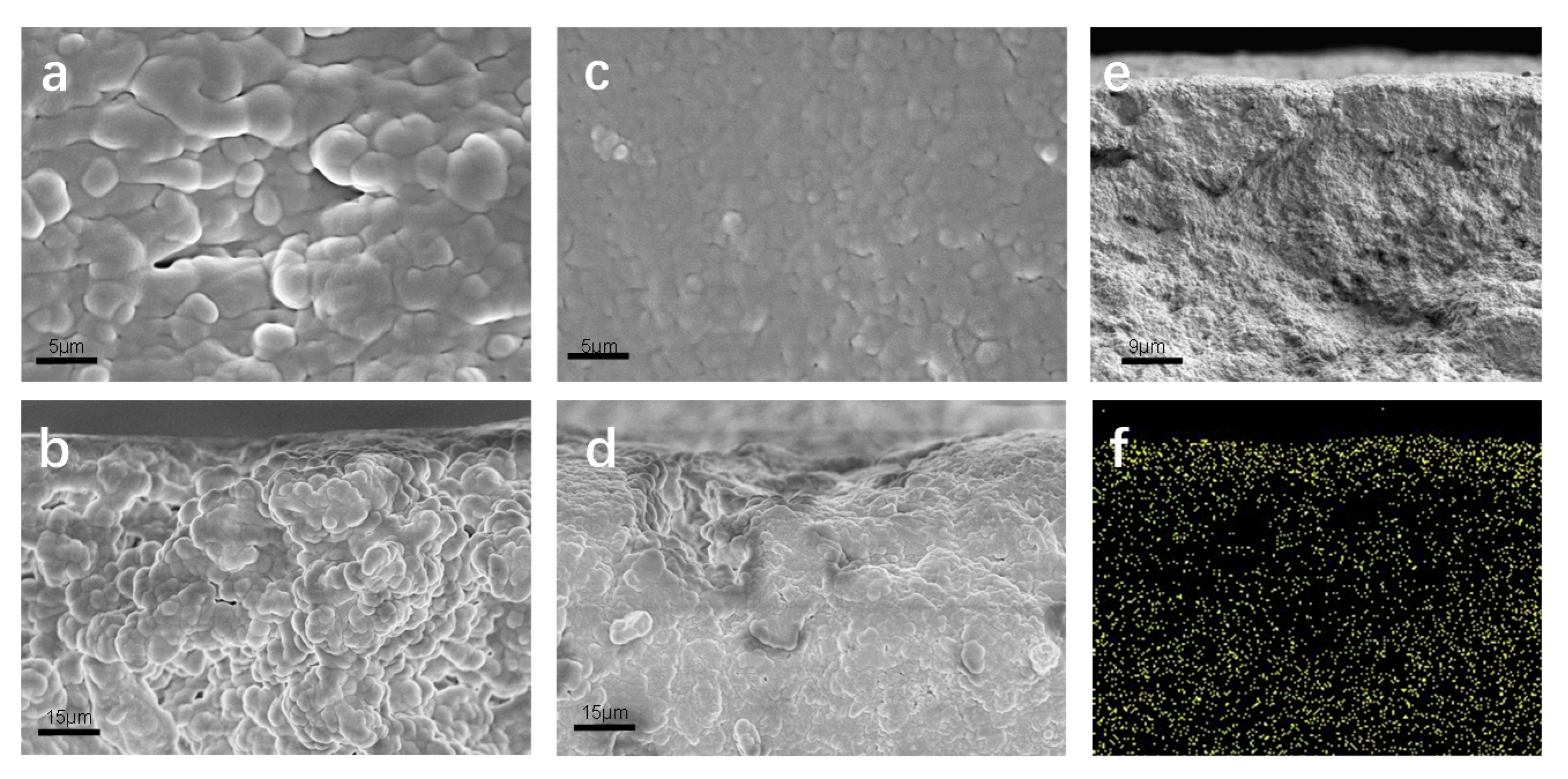



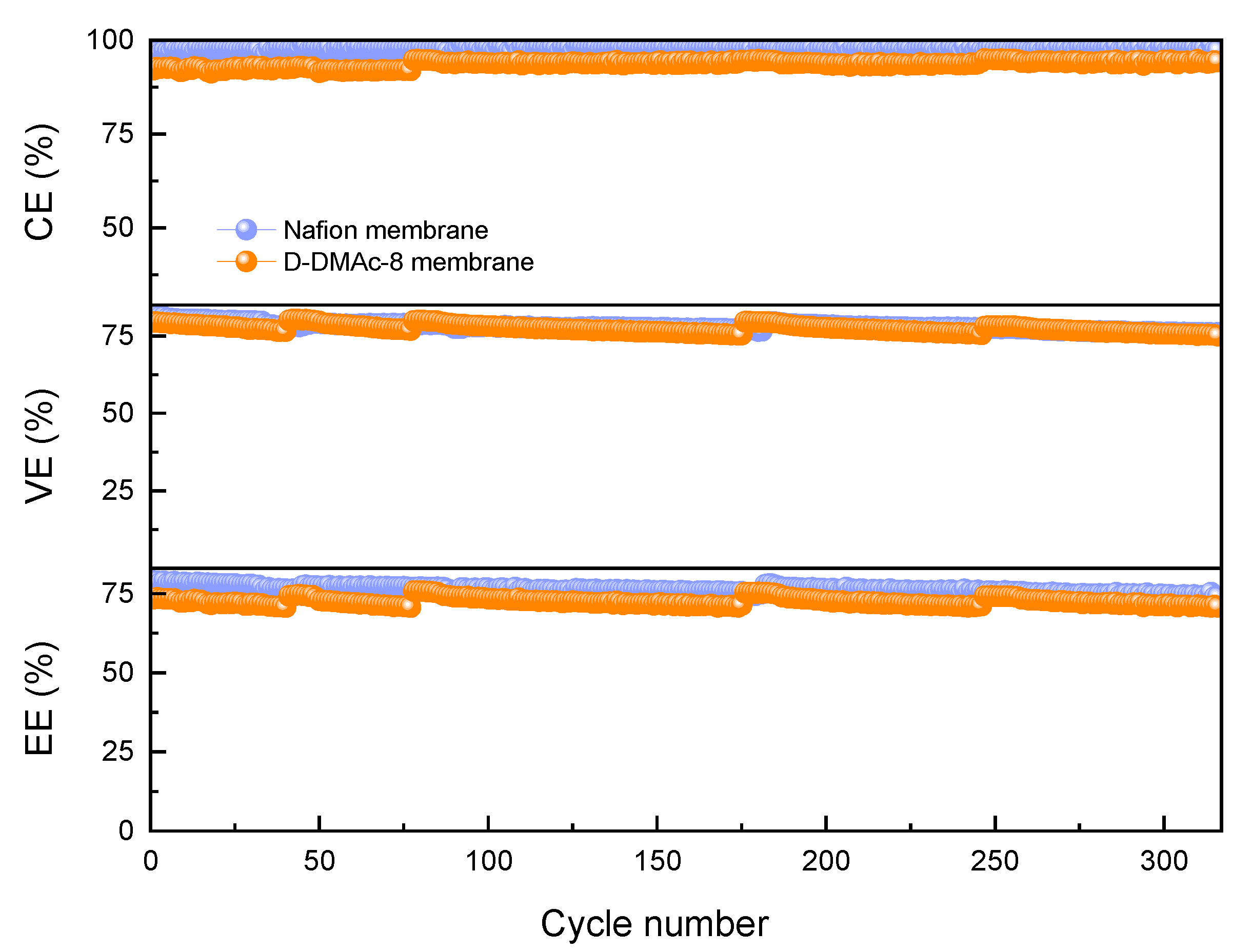

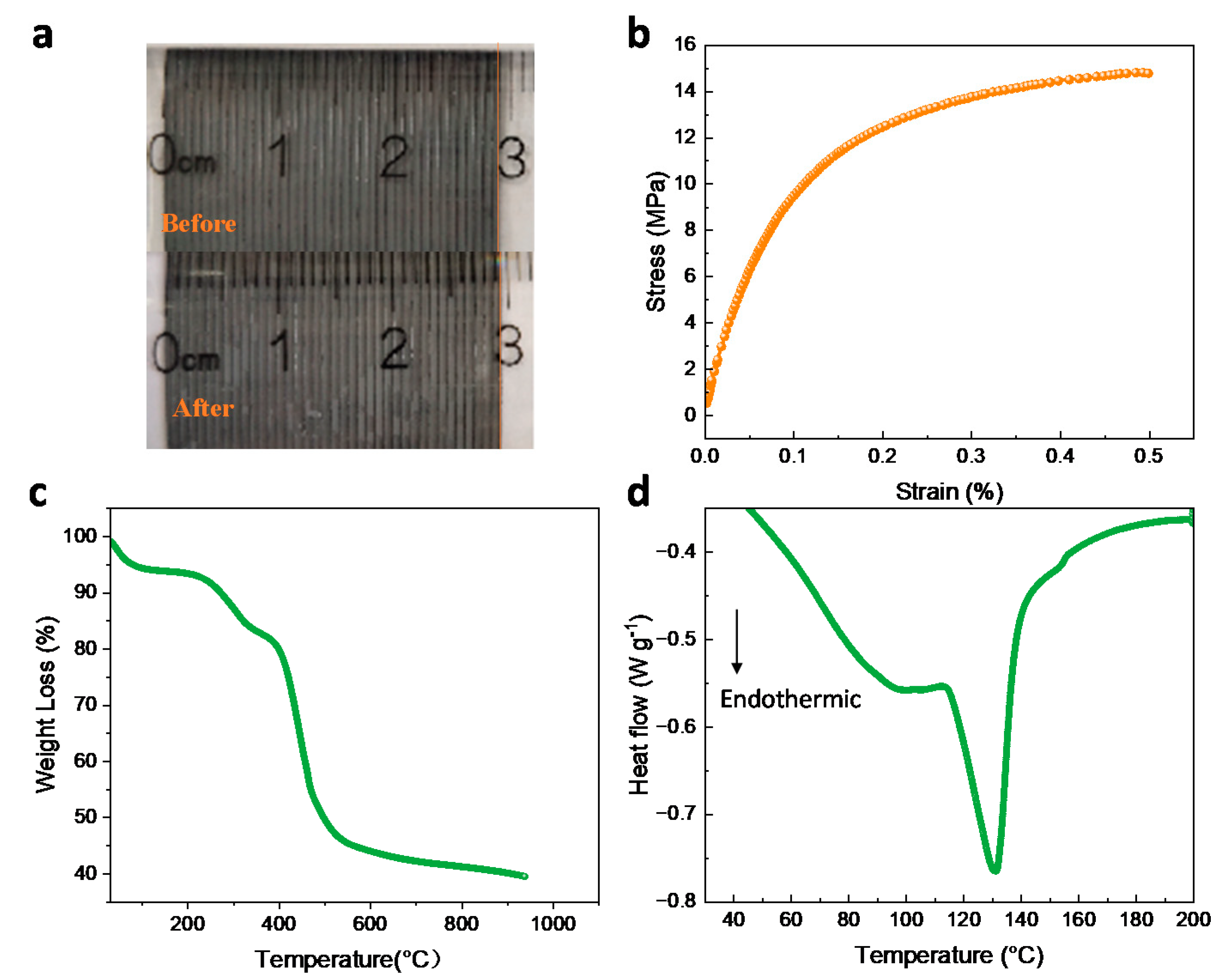
| Cast Solution | H2O Volume Fraction | IPA Volume Fraction | DMAc Volume Fraction | δ | Δδ | Ra | Ra-Ro |
|---|---|---|---|---|---|---|---|
| 5 wt% Nafion (H2O) | 0.89 | 0.11 | 0 | 45.138 | 27.338 | 35.569 | 27.669 |
| 5 wt% Nafion (IPA) | 0.085 | 0.915 | 0 | 25.657 | 7.857 | 13.281 | 5.381 |
| 5 wt% Nafion (DMAc) | 0.085 | 0.11 | 0.805 | 25.013 | 7.213 | 11.410 | 3.510 |
Publisher’s Note: MDPI stays neutral with regard to jurisdictional claims in published maps and institutional affiliations. |
© 2022 by the authors. Licensee MDPI, Basel, Switzerland. This article is an open access article distributed under the terms and conditions of the Creative Commons Attribution (CC BY) license (https://creativecommons.org/licenses/by/4.0/).
Share and Cite
Qiao, L.; Liu, S.; Fang, M.; Yang, M.; Ma, X. A Composite Membrane with High Stability and Low Cost Specifically for Iron–Chromium Flow Battery. Polymers 2022, 14, 2245. https://doi.org/10.3390/polym14112245
Qiao L, Liu S, Fang M, Yang M, Ma X. A Composite Membrane with High Stability and Low Cost Specifically for Iron–Chromium Flow Battery. Polymers. 2022; 14(11):2245. https://doi.org/10.3390/polym14112245
Chicago/Turabian StyleQiao, Lin, Shumin Liu, Maolin Fang, Mingjun Yang, and Xiangkun Ma. 2022. "A Composite Membrane with High Stability and Low Cost Specifically for Iron–Chromium Flow Battery" Polymers 14, no. 11: 2245. https://doi.org/10.3390/polym14112245
APA StyleQiao, L., Liu, S., Fang, M., Yang, M., & Ma, X. (2022). A Composite Membrane with High Stability and Low Cost Specifically for Iron–Chromium Flow Battery. Polymers, 14(11), 2245. https://doi.org/10.3390/polym14112245





